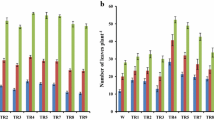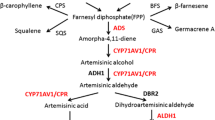Abstract
Artemisinin, an endoperoxide sesquiterpene lactone, is a novel antimalarial natural product isolated from Artemisia annua L. plants. The low concentrations (0.01–1.1%) of this compound in A. annua L. plants is, however, a major constraint for commercialization of artemisinin-based combination therapies (ACTs) recommended by WHO for treating malaria caused by multidrug-resistant P. falciparum sp. In this context, in vivo yield improvement programs were undertaken by us. In the present study, HMG-Co A reductase gene (hmgr) from Catharanthus roseus (L) G. Don and amorpha-4,11-diene synthase (ads) gene from A. annua L. were over-expressed in A. annua L. plants to study their effects on artemisinin yields. The transgenic lines developed from putative transgenic regenerants were evaluated for integration and copy number of the transgenes using hptII gene probe, as it was a part of the expression cassette. The transgenic lines showed positive bands of hptII gene on Southern blots confirming the integration of transgenes. Some of the transgenic lines had single copy of the transgenes, while others had multiple copies. The expressions of hmgr and ads at the transcriptional level were also confirmed in each transgenic line employing RT-PCR assays. The HPLC analyses showed that the artemisinin contents were significantly increased in these transgenics. One of the transgenic lines, TR4, was found to contain 7.65-fold higher (1.73 mg/gDW) artemisinin than the non-transgenic plant (W). The increased artemisinin levels were found to be correlated with HMG-Co A reductase and amorpha-4,11-diene synthase enzymatic activities in the biochemical analyses.






Similar content being viewed by others
Abbreviations
- ACT:
-
Artemisinin-based combination therapy
- ADS:
-
Amorpha-4,11-diene synthase enzyme
- ads :
-
Amorpha-4,11-diene synthase gene
- BAP:
-
Benzene amino purine
- CTAB:
-
Cetyl trimethylammonium bromide
- HMGR:
-
Hydroxy methyl glutaryl coenzyme A reductase
- hmgr :
-
Hydroxy methyl glutaryl coenzyme A gene
- HPLC:
-
High performance liquid chromatography
- MS:
-
Murashige and Skoog
- MVA:
-
Mevalonic acid
- NAA:
-
Naphthalene acetic acid
- NOS:
-
Nopaline opine synthase
- hptII:
-
Hygromycin phosphotransferase gene
- RT-PCR:
-
Reverse transcriptase polymerase chain reaction
- SIM:
-
Shoot-induction medium
- SISM:
-
Shoot-induction selection medium
References
Abdin MZ, Israr M, Rehman RU, Jain SK (2003) Artemisinin, a novel antimalarial drug: biochemical and molecular approaches for enhanced production. Planta Med 69:289–293
Akhila A, Thakur RS, Popli SP (1987) Biosynthesis of artemisinin in Artemisia annua. Phytochem 16:1927–1930
Alam P, Kiran U, Ahmad MM, Kamaluddin, Khan MA, Jhanwar S, Abdin MZ (2010) Isolation, characterization and structural features of amorpha-4,11-diene synthase (ADS3963) from Artemisia annua L. Bioinformation 4:421–429
Aquil S, Husaini AM, Abdin MZ, Rather GM (2009) Overexpression of the HMG-CoA reductase gene leads to enhanced artemisinin biosynthesis in transgenic Artemisia annua plants. Planta Med 75:1–6
Argolo ACC, Charlwood BV, Pletsch M (2000) The regulation of solasodine production by Agrobacterium rhizogenes-transformed roots of Solanum aviculare. Planta Med 66:448–451
Arsenault PR, Vail DR, Wobbe KK, Weathers PJ (2010a) Effect of sugars on artemisinin production in Artemisia annua L.: transcription and metabolite measurements. Molecules 15:2302–2318. doi:10.3390/molecules15042302
Arsenault PR, Vail D, Wobbe KK, Erickson K, Weathers PJ (2010b) Reproductive development modulates gene expression and metabolite levels with possible feedback inhibition of artemisinin in Artemisia annua L. Plant Physiol 154:958–968
Ayora-Talavera T, Chappell J, Lozoya-Gloria E, Loyola-Vargas VM (2002) Overexpression in Catharanthus roseus hairy roots of a truncated hamster 3-hydroxy-3-methylglutaryl-CoA reductase gene. Appl Biochem Biotechnol 97:135–145
Bharel S, Gulati A, Abdin MZ, Srivastava PS, Vishwakarma RA, Jain SK (1998) Enzymatic synthesis of artemisinin from natural and synthetic precursors. J Nat Prod 61:633–636
Bouwmeester HJ, Wallaart TE, Janssen MHA, van Loo B, Jansen BJM, Posthumus MA, Schmidt CO, De Kraker JW, Konig WA, Franssen MCR (1999) Amorpha-4,11-diene synthase catalyzes the first probable step in artemisinin biosynthesis. Phytochemistry 52:843–854
Bradford MM (1976) A rapid and sensitive method for the quantitation of microgram quantities of protein utilizing the principle of protein dye binding. Anal Biochem 72:248–254
Chappell J (1995) Biochemistry and molecular biology of the isoprenoid biosynthetic pathway in plants. Annu Rev Plant Physiol Plant Mol Biol 46:521–547
Chen D, Ye H, Li G (2000) Expression of a chimeric farnesyl diphosphate synthase gene in Artemisia annua L. transgenic plants via Agrobacterium tumefaciens-mediated transformation. Plant Sci 155:179–185
Covello PS (2008) Making artemisinin. Phytochemistry 69:2881–2885
Covello PS, Teoh KH, Polichuk DR, Reed DW, Nowak G (2007) Functional genomics and the biosynthesis of artemisinin. Phytochemistry 68:1864–1871
Dhingra V, Rao VM, Narasu L (2000) Current status of artemisinin and its derivatives as anti-malarial drugs. Life Sci 66:279–300
Doyle JJ, Doyle JL (1990) Isolation of plant DNA from fresh tissue. Focus 12:13–15
Duke SO, Paul RN (1993) Development and fine structure of glandular trichomes of s L. Int. J Plant Sci 154:107–118
Duke MV, Paul RN, El-Sohly HN, Sturtz G, Duke SO (1994) Localization of artemisinin and artemisitene in foliar tissues of glanded and glandless biotypes of Artemisia annua L. Int. J. Plant Sci. 155:365–372
Graham IA, Besser K, Blumer S, Branigan CA, Czechowski T, Elias L, Guterman I, Harvey D, Isaac PG, Khan AM, Larson TR, Li Y, Pawson T, Penfield T, Rae AM, Rathbone DA, Reid S, Ross J, Smallwood MF, Segura V, Townsend T, Vyas D, Winzer T, Bowles D (2010) The genetic map of Artemisia annua L. identifies loci affecting yield of the antimalarial drug artemisinin. Science 327:328–331
Han JL, Wang H, Ye HC, Liu Y, Li ZQ, Zhang Y, Zhang YS, Yan F, Li GF (2005) High efficiency of genetic transformation and regeneration of Artemisia annua L. via Agrobacterium tumefaciens-mediated procedure. Plant Sci 168:73–80
Han JL, Liu BY, Ye HC, Wang H, Li ZQ, Li GF (2006) Effects of over expression of the endogenous farnesyl diphosphate synthase on the artemisinin content in Artemisia annua L. J Integr Plant Biol 48:482–487
Haynes RK (2006) From artemisinin to new artemisinin antimalarials: biosynthesis, extraction, old and new derivatives, stereochemistry and medicinal chemistry requirements. Curr Top Med Chem 6:509–537
Hobbs SLA, Warkentin TD, DeLong CMO (1993) Transgene copy number can be positively or negatively associated with transgene expression. Plant Mol Biol 21:17–26
Koobkokkruad T, Chochai A, Kirdmanee C, De-Eknamkul W (2008) Effects of low-dose gamma irradiation on artemisinin content and amorpha-4,11-diene synthase activity in Artemisia annua L. Int J Radiat Biol 84:878–884
Kudakasseril GJ, Lam L, Staba EJ (1987) Effect of sterol inhibitors on the incorporation of 14C-isopentenyl pyrophosphate into artemisinin by a cell-free system from Artemisia annua tissue cultures and plants. Planta Med 53:280–284
Laughlin JC (1994) Agricultural production of artemisinin: a review. Trans Royal Soc Trop Med Hyg 88:21–22
Li GQ, Guo XB, Jin R, Wang ZC, Jain HX, Li ZY (1982) Clinical studies on treatment of cerebral malaria with quinghaosu and its derivatives. J Trad Chin Med 2:125–130
Lommen WJ, Schenk E, Bouwmeester HJ, Verstappen FW (2006) Trichome dynamics and artemisinin accumulation during development and senescence of Artemisia annua leaves. Planta Med 72:336–345
Luo XD, Shen CC (1987) The chemistry, pharmacology and clinical applications of qinghaosu (artemisinin) and its derivatives. Med Res Rev 7:29–52
Maldonado MIE, Burnett RJ, Nessler CL (1992) Nucleotide sequence of a cDNA encoding 3-hydroxy-3-methylglutaryl coenzyme A reductase from Catharanthus roseus. Plant Physiol 100:1613–1614
Mauji Ram, Khan MA, Jha P, Khan S, Kiran U, Ahmad MM, Javed S, Abdin MZ (2010) HMG-CoA reductase limits artemisinin biosynthesis and accumulation in Artemisia annua L. plants. Acta Physiol Plant 32:859–866
Mercke P, Bengtsson M, Bouwmeester HJ, Posthumus MA, Brodelius PE (2000) Molecular cloning, expression, and characterization of amorpha-4,11-diene synthase, a key enzyme of artemisinin biosynthesis in Artemisia annua L. Arch Biochem Biophys 381:173–180
Meyer P (1995) Understanding and controlling transgene expression. Trends Biotechnol 13:332–337
Nafis T, Akmal M, Ram Mauji, Alam P, Ahlawat S, Mohammad A, Abdin MZ (2011) Enhancement of artemisinin content by constitutive expression of HMG CoA Reductase gene in high yielding strain of Artemisia annua L. Plant Biotechnol Rep 5:53–60
Nair MSR, Basile DV (1993) Bioconversion of arteannuin B to artemisinin. J Nat Prod 56:1559–1566
Russell DW (1985) 3-Hydroxy-3-methylglutaryl-CoA reductases from pea seedlings. Methods Enzymol 110:26–40
Sa G, Mi M, He-Chun Y, Ben-Ye L, Guo-feng L, Kang C (2001) Effects of ipt gene expression on the physiological and chemical characteristics of Artemisia annua L. Plant Sci 160:691–698
Schramek N, Wang H, Römisch-Margl W, Keil B, Radykewicz T, Winzenhörlein B, Beerhues L, Bacher A, Rohdich F, Gershenzon J, Liu B, Eisenreich W (2010) Artemisinin biosynthesis in growing plants of Artemisia annua. A 13CO2 study. Phytochemistry 71:179–187
Spiker S, Thompson WF (1996) Nuclear matric attachment regions and transgene expression in plants. Plant Physiol 110:15–21
Tang W, Ronald J, Newton D, Weidner A (2007) Genetic transformation and gene silencing mediated by multiple copies of a transgene in eastern white pine. J Exp Bot 58:545–554
Towler MJ, Weathers PJ (2007) Evidence of artemisinin production from IPP stemming from both the mevalonate and the nonmevalonate pathways. Plant Cell Rep 26:2129–2136
Van der Krol A, Mur L, Beld M, Mol JNM, Stuitje AR (1990) Flavonoid genes in petunia: addition of a limited number of gene copies may lead to a suppression of gene expression. Plant Cell 2:291–299
Wallaart TE, Bouwmeester HJ, Hille J, Poppinga L, Maijers NC (2001) Amorpha-4,11-diene synthase: cloning and functional expression of a key enzyme in the biosynthetic pathway of the novel anti-malarial drug artemisinin. Planta 212:460–465
Weathers PJ, Arsenault PR, Covello PS, McMickle A, Teoh KH, Reed DW (2010) Artemisinin production in Artemisia annua: studies in planta and results of a novel delivery method for treating malaria and other neglected diseases. Phytochem Rev. doi:10.1007/s11101-010-9166-0
Zhang Y, Teoh KH, Reed DW, Maes L, Goossens A, Olson DJ, Ross AR, Covello PS (2008) The molecular cloning of artemisinic aldehyde D11(13) reductase and its role in glandular trichome-dependent biosynthesis of artemisinin in Artemisia annua. J Biol Chem 283:21501–21508
Zhang L, Jing F, Li F, Li M, Wang Y, Wang G, Sun X, Tang K (2009) Development of transgenic Artemisia annua (Chinese wormwood) plants with an enhanced content of artemisinin, an effective anti-malarial drug, by hairpin-RNA mediated gene silencing. Biotechnol Appl Biochem 52:199–207
Zhao SS, Zeng MY (1986) Determination of qinghaosu in Artemisia annua L. by high performance liquid chromatography. Chin J Pharm Ana 6:3–5
Zhu W, Sheng X (2003) Correlation between histochemical location and content of artemisinin. Zhongcaoyao 34:852–854
Acknowledgments
We are thankful to Prof. S.K. Jain, Department of Biotechnology, Faculty of Science, Jamia Hamdard, New Delhi, India, and Dr. M.A.A. Khan Scientist, NISCAIR, New Delhi, India, for editing the manuscript. The financial support from DST, Government of India and M/s Ipca Pvt. Ltd., Mumbai, India, is gratefully acknowledged. P.A. is thankful to Jamia Hamdard, New Delhi, India, for providing Junior Research Fellowship.
Author information
Authors and Affiliations
Corresponding author
Additional information
Communicated by P. Lakshmanan.
Rights and permissions
About this article
Cite this article
Alam, P., Abdin, M.Z. Over-expression of HMG-CoA reductase and amorpha-4,11-diene synthase genes in Artemisia annua L. and its influence on artemisinin content. Plant Cell Rep 30, 1919–1928 (2011). https://doi.org/10.1007/s00299-011-1099-6
Received:
Revised:
Accepted:
Published:
Issue Date:
DOI: https://doi.org/10.1007/s00299-011-1099-6




